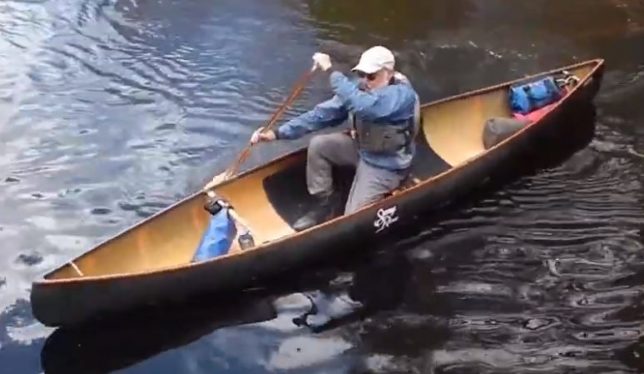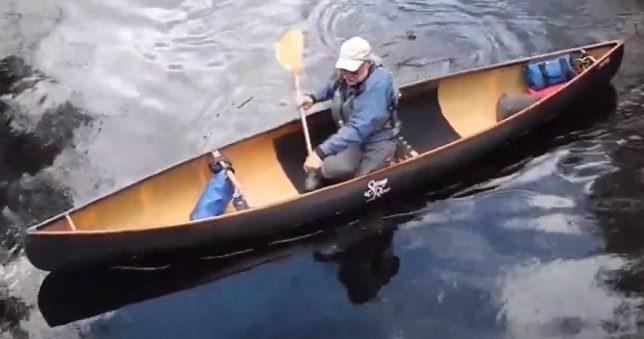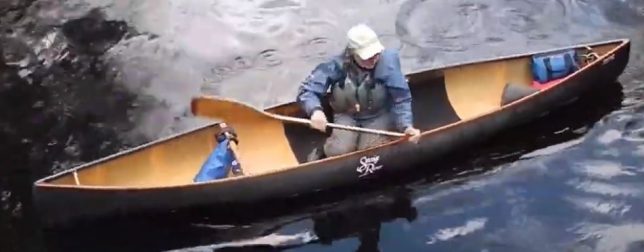by Marc Ornstein
In part one of this series, we discussed the basic reverse stroke, reverse J and reverse sweep. In part two of this article, we explored the far back and compound reverse strokes. In this part three we’ll explore my favorite method of traveling backward, cross reverse.
When I first mention cross reverse most folks react by rolling their eyes, shaking their heads or with some similarly dismissive gesture. They picture themselves in some contorted position, more akin to a circus side show than a relaxing paddle. They assume this is some sort of show-off move, best left to FreeStyle exhibition or competition. I assure you that it is none of that. It is in fact, the best way to travel in reverse, especially if you have to travel any significant distance. In cross reverse it is easier to control your direction than in any other method of traveling backwards. It is also a very powerful position, and especially useful if you have to back up, upstream.
The key to cross reverse is getting your body into the proper position, that being cross-transverse or cross-semi-transverse. Radically moving around in the canoe is an entire topic unto itself. At our canoe symposiums, we often offer an entire class, dedicated to that subject but since it is a necessary component to this article, I’ll cover the basics.
Picture being transverse in the canoe as being sideways, kneeling with both knees in one chine, your belly facing the on-side gunwale and your back facing the offside. Cross-transverse places you with both knees in one chine with your belly facing the off-side gunwale and your back facing the on-side gunwale. You get there from your standard kneeling position in baby steps.
Assuming that you have been paddling from a kneeling position, your 1st move is to pull your on-side foot out from under the seat, so that foot is now resting flat on the bottom of the canoe in front of the seat with the knee now up. Your off-side leg remains kneeling.
You now come up on your off-side knee, while lifting your butt off the seat.
Next step is to pivot toward your off-side and drop your on-side knee into the offside chine, a foot or two forward of the seat.
Finally, slide your off-side foot and leg around so that your calf is parallel to the front seat rail.
You should now be positioned with your belly facing the off-side gunwale. The soles of both feet along with your back are facing the on-side gunwale. Your toes will be curled under.
Getting into Cross-Reverse, 1/4 speed
Semi-transverse is a bit easier and most of the time it is my preferred position. Assuming that you have been paddling from a kneeling position, your 1st move is to pull your on-side foot out from under the seat, so that foot is now resting flat on the bottom of the canoe, in front of the seat. Your off-side leg remains kneeling. You now come up on your off-side knee, while pivoting your butt, on the seat approximately 45 degrees toward the off-side. You are now sitting with your butt partly on the seat, partly hanging off the front. The toes of your off-side foot will be curled under. The toes of your on-side foot may be curled under or not as comfortable. Simultaneously you pivot your on-side leg/knee toward your off-side and drop your on-side knee into the off-side chine. You may reposition your off-side leg/foot (still kneeling beneath the seat) a bit for comfort and stability. You should now be kneeling, while facing approximately 45 degrees toward the off side. Before beginning to paddle, you’ll rotate your torso another 45+- degrees so that your shoulders are approximately parallel to the offside gunwale.
Moving back to a forward paddling position is essentially the opposite of what we just did. Remember to break it down into baby steps. Practice getting into and back out of either the cross-transverse or cross-semi-transverse positions until you are comfortable with them. You must be able to do this reliably before you are ready to paddle in cross-reverse. Once you are comfortable, getting into and out of the cross-transverse or cross-semi-transverse position, it’s time to address paddling in cross-reverse.
For purposes of this discussion, we’ll work from the cross-semi-transverse position. The only real difference between the two, is that paddling from cross-semi-transverse requires a bit more torso rotation.
Once in cross-semi-transverse, reach back toward the canoe’s stern as far as possible. Place the paddle at the catch position, fully submerged, grip hand out over the gunwale, shaft vertical, and blade perpendicular to the keel line. The thumb of the grip hand will be pointed outward from the hull. Be certain that the blade is far enough outboard of the gunwale so that it may be drawn straight forward (toward the bow) without following the curvature of the hull. This is a short stroke, ending when the blade reaches your hip. If using an in-water recovery (most commonly), at the end of the stroke the grip hand is rotated 90 degrees so that the thumb points straight forward (toward the bow) and the blade is sliced back to the placement/catch position for the next stroke. If using a traditional, out of water recovery, when the blade reaches your hip it is sliced out of the water feathered, and returned to the placement/catch position. With the exceptions that you are in a cross-semi-transverse position and that your torso is heavily rotated, this feels (and is) very much like a forward stroke.
If necessary, one can append a correctional “J” to the end of the stroke, just as one would when paddling forward. If adding a “J” allow the paddle to travel a bit further forward (toward the bow) (with little or no power) so that the “J” component is as far forward as can be comfortably managed. The further forward it is from the canoe’s center of rotation, the more effective it will be. I’d suggest reviewing my previous article, “Jayded”). Although that article was focused on the forward J stroke, the principles all still apply, here in cross-reverse.
Just as a “J” can be appended to the end of the stroke so too could a diagonal draw at the beginning, making it a cross-reverse “C” stroke. If there is a need to turn the canoe away from the paddle side, a sweep component can be added to the power portion of the stroke; in fact, wedges, axles, posts or any other FreeStyle move can be done in cross reverse, almost as easily as in the forward quadrant.
The beauty of cross-reverse is that once you have gotten yourself into the cross-transverse or cross-semi-transverse position, it is executed and feels very much like a forward stroke. The directional controls that one uses when paddling forward are done in a similar and familiar manner when in cross-reverse. With the torso heavily wound at the catch, it is a strong stroke with almost all power coming from the large muscles of the torso and little from the arms. From a semi-transverse or transverse position, it is as easy to look sternward as it is to look forward. I often use cross-reverse when leading groups on small streams. It allows me to easily look where I’m going while alternately keeping an eye on the group behind me (or is that in front of me).
Cross-reverse will likely feel intimidating at first. Comfortably getting into and out of cross-transverse, easily, takes a bit of practice before it can be done smoothly and feels natural. The extreme torso rotation required will at first feel awkward but if you stick with it, I suspect it may become your favorite way of traveling backward.